Criminal justice social work statistics: 2020 - 2021
Mainly national-level information on criminal justice social work activity in Scotland in the first full year affected by the Covid-19 pandemic. Includes data on justice social work services and social work orders, as well as characteristics of the individuals involved.
5.2 Community payback orders
(Tables 2 & 8-17 and Charts 2-6)
5.2.1 The number of community payback orders (CPOs) imposed increased in the initial years following their introduction, reaching 19,500 in 2015-16 (Table 2). This rise was expected due to CPOs replacing legacy orders for offences committed on or after 1 February 2011. The total CPOs imposed then fell in the next three years to 16,500 in 2018-19, before a small rise to 16,800 in 2019-20. The COVID-19 pandemic and the resulting decrease in court business meant numbers fell sharply in 2020-21, by 51 per cent to 8,200.
5.2.2 Chart 2 shows how numbers imposed were lower in every month of 2020-21 than they were in the equivalent month in 2019-20. This was particularly the case during the period April to June 2020 when COVID-19 restrictions were at their highest level. Numbers were nearer normal between September and December 2020 but fell in the early part of 2021 when further restrictions were in place.
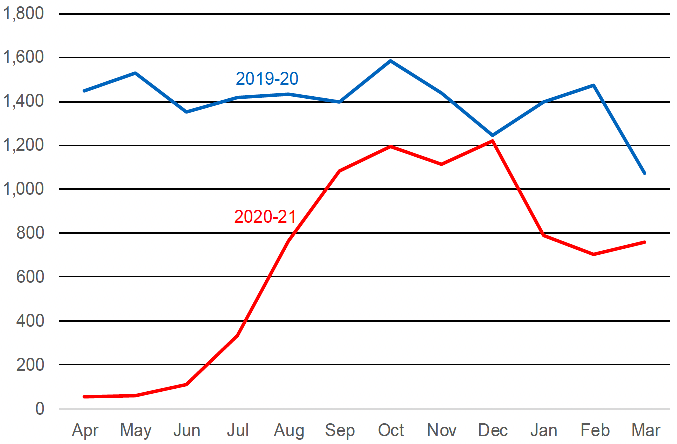
Note : Figures for 2020-21 include estimates for Renfrewshire.
5.2.3 In 2020-21, there were 21 CPOs imposed per 10,000 population (Chart 3). This proportion was lower for Scotland and for every council in 2020-21 than in 2019-20. In 2020-21, the proportion was highest for those living in Dumfries & Galloway (48) followed by West Dunbartonshire (38) and Clackmannanshire (37). The lowest proportions were for those living in East Renfrewshire (7), Na h-Eileanan Siar (8) and City of Edinburgh (9). While the proportion for City of Edinburgh was considerably lower than for Scotland as a whole, the city council areas of Aberdeen (30) and Glasgow (27) were both considerably higher than the national average. More detailed information by local authority area can be found in the additional datasets which accompany this publication.
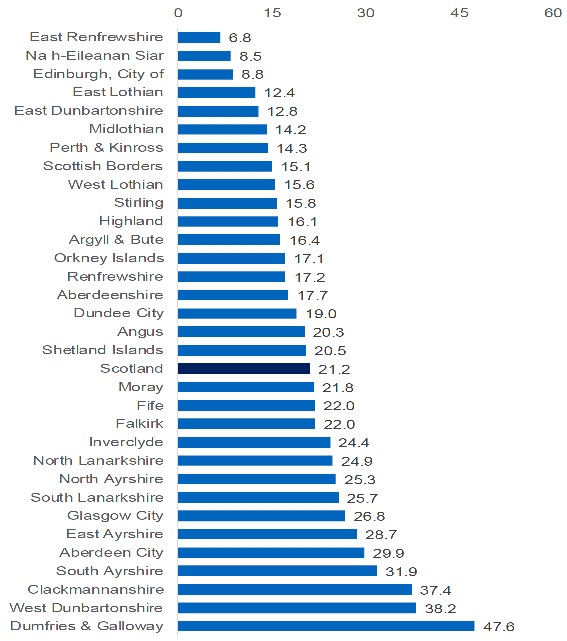
Notes : Population aged 16 to 70. Figures for Renfrewshire are estimates.
Requirements
5.2.4 A CPO can contain up to nine different requirements at first imposition. Every order should have either or both an unpaid work or other activity requirement or an offender supervision requirement.
5.2.5 For every year up to 2019-20, unpaid work or other activity was the requirement most commonly issued as part of a CPO. The proportion of orders with unpaid work was high in the early years after the orders were introduced, peaking at 80 per cent in 2013-14. This then fell slightly in each of the next six years, reaching 70 per cent in 2019-20 (Table 9 and Chart 4), but fell sharply to 58 per cent in 2020-21.
5.2.6 The average number of hours given as part of unpaid work requirements has risen steadily in each of the last four years, reaching 131 hours in 2020-21 (Table 10). The proportion of unpaid work requirements which are level 2 (over 100 hours) has increased from 48 per cent in 2016-17 to 56 per cent in 2020-21.
5.2.7 In contrast, the proportion of orders with an offender supervision requirement has been rising over recent years, reaching 62 per cent in 2019-20 (Table 9 and Chart 4). This proportion then rose sharply in 2020-21 to 73 per cent.
5.2.8 In the years 2016-17 to 2019-20, around 56 to 58 per cent of supervision requirements were for 12 months or less (Table 11). This fell to 51 per cent in 2020-21. The average length of supervision requirements across 2016-17 to 2019-20 was around 15.5 months but was higher (16.7 months) in 2020-21.
5.2.9 Chart 4 illustrates how much the composition of orders has changed since 2014-15. Greater use is being made of offender supervision and less is being made of unpaid work or other activity. In 2014-15, 78 per cent of orders had an unpaid work requirement and 50 per cent had a supervision requirement. By 2019-20, unpaid work still remained the most common requirement, but its prevalence had fallen to 70 per cent, while supervision had risen to 62 per cent. There was a major change in 2020-21 when the proportion with unpaid work dropped markedly to 58 per cent while those with supervision showed a big increase to 73 per cent.
5.2.10 The type of orders being issued in 2020-21 was likely to have been influenced significantly by the impact of the pandemic. Face-to-face delivery of unpaid work had to be suspended for periods during the year and courts would have been aware of the challenges of delivering unpaid work. Factors relating to the nature of cases which had court hearings during the pandemic and the circumstances of the individuals involved may also have been a relevant factor.
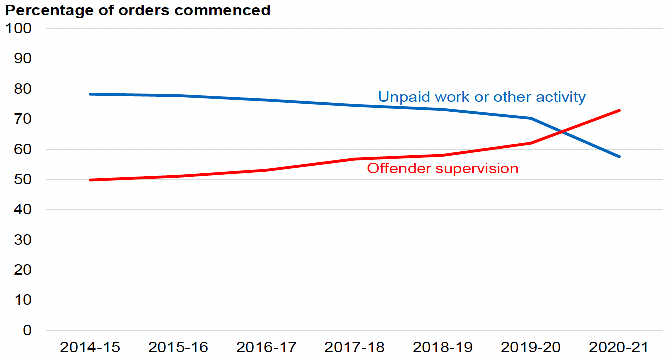
Note : Figures for 2020-21 include estimates for Renfrewshire.
5.2.11 The other seven CPO requirements, which should only be issued alongside offender supervision, are:
- Conduct
- Programme
- Alcohol treatment
- Compensation
- Drug treatment
- Mental health treatment
- Residence
5.2.12 Conduct and programme have been the most commonly issued of these requirements (Table 9). The proportion of orders with conduct requirements has risen in each of the last four years. There was a particularly marked rise in the last year from ten per cent in 2019-20 to 12 per cent in 2020-21. This is likely to reflect the sharp increase in the proportion of orders with offender supervision requirements over this period. The proportion of orders with a programme requirement has risen in each of the last three years and now sits at nine per cent of all orders in 2020-21, up from seven per cent in 2019-20.
5.2.13 The prevalence of the other five requirements remained at around the same level in 2020-21 as they were in 2019-20 (Table 9).
5.2.14 The average number of requirements per order has been steadily rising over the last five years, increasing from 1.48 in 2016-17 to 1.57 in 2020-21 (Tables 8 & 9).
5.2.15 People aged 18 to 20 were previously the most likely to be given a CPO, with 85 people per 10,000 population given an order in 2019-20. However, in 2020-21, it was those aged 26 to 30 who were the most likely, with 39 per 10,000 population of this age group given an order in that year. The proportion for those aged 18 to 20 in 2020-21 was only slightly less, at 38 per 10,000.
5.2.16 People receiving CPOs have been getting slightly older each year. The proportion aged 25 and under has fallen from 33 per cent in 2016-17 to 25 per cent in 2020-21, while those aged over 30 now account for 56 per cent of the total compared with 49 per cent in 2016-17 (Table 8). The fall in the prevalence for young people reflects the marked fall in court volumes for this age group. As a result of these changes over time, the average age of a CPO recipient has risen by four years from 30 in 2012-13 to 34 in 2020-21.
5.2.17 The proportion of orders issued to males remained more or less unchanged in 2020-21, at 86 per cent (Table 8). Three-quarters of those receiving orders were either unemployed or economically inactive in 2020-21 and a further 22 per cent were in employment or self-employed.
5.2.18 There were a total of 14,300 CPOs in force at 31 March 2021 (see Table 2 and the additional datasets which accompany this publication). This was 12 per cent lower than at 31 March 2020.
5.2.19 Chart 5 shows how the numbers in force changed throughout the year. Numbers went down in the period up to August, reflecting the closure over this period of many courts. Numbers picked up during the remainder of 2020 as more cases were able to be concluded in courts. The drop in March 2021 was influenced significantly by The Community Orders (Coronavirus) (Scotland) Regulations 2021 coming into force. Under these regulations, existing orders with unpaid work (with the exception of those imposed for offences involving domestic abuse, sexual offences or stalking) had their specified hours reduced by 35 per cent and, in some cases, this resulted in the order finishing.
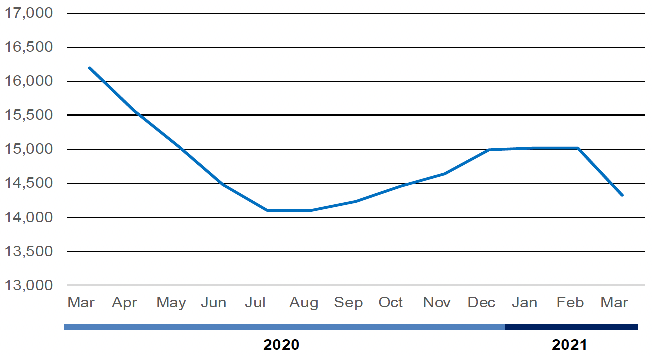
Note : Figures include estimates for Renfrewshire.
Timescales for implementation
5.2.20 The Scottish Government community payback order practice guidance is intended to support practitioners and managers to improve their performance and work towards the achievement of the national outcomes and standards for social work services in the criminal justice system. Further details on the guidance can be found in §B.6.
5.2.21 First direct contact took place within one working day of imposition for 58 per cent of orders imposed in 2020-21 (Table 12). This was considerably lower than in the previous four years when it generally fluctuated around the 75 per cent mark. In addition, in 2020-21, 23 per cent took more than five working days.
5.2.22 In 2020-21, 68 per cent of first induction / case management meetings took place within five working days. Again, this was lower than in the previous four years, when generally just under 80 per cent took place within that timescale. Roughly equal proportions took six to ten working days and more than ten working days.
5.2.23 The proportion of unpaid work placements which started within seven working days in 2020-21 was 49 per cent, considerably lower than the levels of around 70 per cent seen over the last four years (Table 13).
5.2.24 The lower proportions in 2020-21 for these timescales were expected due to the impact of the COVID-19 pandemic and related public health measures to keep people safe.
Terminations
5.2.25 The successful completion rate for CPOs terminated in 2020-21 was 75 per cent (Table 2). This was higher than the rate in the previous six years when it was generally around 70 per cent. Caution is needed in interpreting this due to the impact of COVID-19 and the regulations reducing some unpaid work requirements. Chart 6 illustrates completion rates over the year by month. In the period from April to July 2020, the number of orders terminating was low, although the proportion which were successfully completed was very high, at 85 per cent. In the remainder of 2020, both numbers and completion rates were nearer to the levels witnessed in recent years.
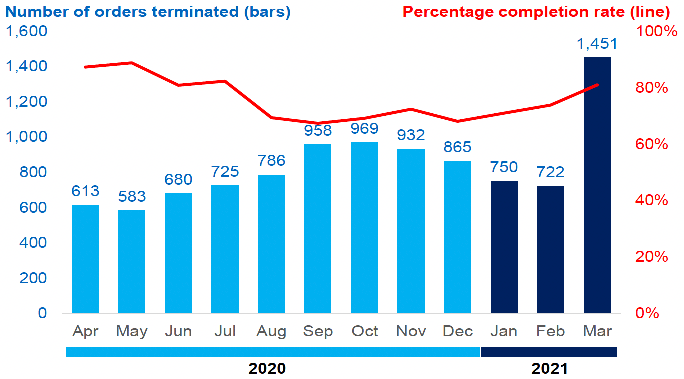
Note : Figures include estimates for Renfrewshire.
5.2.26 Chart 6 also shows that, in March 2021, the number of orders terminating rose very sharply, accounting for 14 per cent of the whole year's total. This was influenced by The Community Orders (Coronavirus) (Scotland) Regulations 2021 which came into force on 15 March 2021. These regulations reduced the hours of unpaid work requirements, as originally imposed by the court, by 35 per cent, with exceptions for orders imposed involving domestic abuse, sexual offences or stalking. As a result, some orders were automatically completed due to sufficient hours having already been delivered. In March 2021, the successful completion rate was also high (81 per cent).
5.2.27 In 2020-21, 11 per cent of orders terminated were revoked following a breach application to the courts and a further seven per cent were revoked following a review (Table 14).
5.2.28 Seventy-nine per cent of orders which finished during 2020-21 did not involve any breach applications during the lifetime of the order (Table 15). For the remainder, there were a total of 2,500 breach applications made (Table 16). The vast majority of breach applications (77 per cent) were lodged with the court within five working days of the decision to make an application.
5.2.29 For CPOs revoked due to breach, the most likely specific outcomes were an "other" outcome (31 per cent), a new order (24 per cent) and a custodial sentence (21 per cent) (Table 14). Fifteen per cent of orders revoked due to review resulted in a custodial sentence, another 16 per cent got a new CPO or a monetary penalty, while 50 per cent had an "other" outcome.
5.2.30 During 2020-21, a total of 3,000 unpaid work or other activity requirements were successfully completed (Table 17). This was substantially fewer than in previous years, reflecting the fact that fewer unpaid work requirements were imposed (in particular level 1 requirements) and also issues impacting the delivery of unpaid work, both of which are related to the impact of the Coronavirus pandemic and related public health measures. On average, 124 hours were carried out for each order. The time taken to complete was around 13 months which was considerably longer than in previous years. This was expected given that the Coronavirus (Scotland) Act 2020 extended time limits for unpaid work in CPOs by 12 months, and required similar time limits to be imposed in any new orders made. This came into effect on 7 April 2020.
Contact
Email: Justice_Analysts@gov.scot
There is a problem
Thanks for your feedback